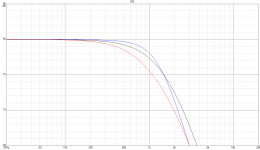Yes, in theory, it would. However, the difference is not likely to be noticeable (<1dB or so). A similar (small) change in the Q-factor (peaking characteristics) of the filter would also result (if applicable), as the speaker impedance remains the same as before.
Mads Buchardt, president of Buchardt Audio and creator of the S400 speaker said that in his crossover, a .5uF deviation is not audible when I emailed him about capacitor upgrades for his crossover design as I couldn't find a like for like replacement and had to go up .1uF. So according to him, in his crossover, even a .5uF deviation is within sonic specifications. I agree with newvirus2008 that bumping it up 1.2uF will not likely be noticeable.
You can go higher in capacitor value and add a little resistance, say 10 uF and 1 ohm....
Same for highpass: a resistor in series to the coil( to ground) reduces its action, i. e. makes the slope more gentle
Same for highpass: a resistor in series to the coil( to ground) reduces its action, i. e. makes the slope more gentle
You can think about a capacitor as a "high pass" device.
It blocks lower frequencies and allows higher frequencies to pass through.
A larger capacitor value will allow lower frequencies to pass than a smaller capacitor value.
In your circuit, the capacitor in question is shunted across the driver. The larger value capacitor will allow signal to pass through it at a slightly lower frequency than the smaller value cap. Consequently, less signal goes through the MF driver.
As a rough comparison, I used LspCad to sim the response for a fullrange driver that I have data for. In the circuit that you show, the -6 dB point on the upper rolloff might be around 5.5 kHz for the 5.6 uF, but reduced to about 4.5 kHz for the 6.8 uF. Might be audible. Might not. A lot depends on the real response and impedance of the actual driver.
Hope this helps.
It blocks lower frequencies and allows higher frequencies to pass through.
A larger capacitor value will allow lower frequencies to pass than a smaller capacitor value.
In your circuit, the capacitor in question is shunted across the driver. The larger value capacitor will allow signal to pass through it at a slightly lower frequency than the smaller value cap. Consequently, less signal goes through the MF driver.
As a rough comparison, I used LspCad to sim the response for a fullrange driver that I have data for. In the circuit that you show, the -6 dB point on the upper rolloff might be around 5.5 kHz for the 5.6 uF, but reduced to about 4.5 kHz for the 6.8 uF. Might be audible. Might not. A lot depends on the real response and impedance of the actual driver.
Hope this helps.
Playing with this calculator will give you an idea of what's happening:
http://www.mh-audio.nl/Calculators/CalculateQ12db.html
http://www.mh-audio.nl/Calculators/CalculateQ12db.html
- Home
- Loudspeakers
- Multi-Way
- Capacitor in crossovers
